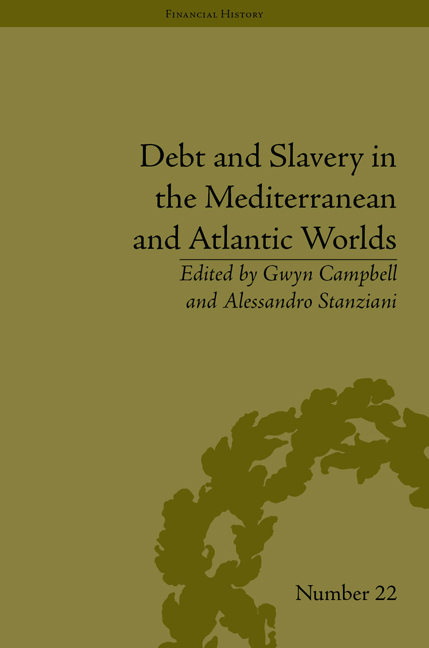Book contents
- Frontmatter
- Contents
- Acknowledgements
- List of Contributors
- Introduction
- 1 Debt Bondage and Chattel Slavery in Early Rome
- 2 Slavery, Debt and Bondage: The Mediterranean and the Eurasia Connection from the Fifteenth to the Eighteenth Century
- 3 Clientship, Social Indebtedness and State-Controlled Emancipation of Africans in the Late Ottoman Empire
- 4 Pawnship and Seizure for Debt in the Process of Enslavement in West Africa
- 5 The Business of ‘Trust’ and the Enslavement of Yoruba Women and Children for Debt
- 6 The Africanization of the Workforce in English America
- 7 Credit, Captives, Collateral and Currencies: Debt, Slavery and the Financing of the Atlantic World
- 8 Unpayable Debts: Reinventing Bonded Labour through Legal Freedom in Nineteenth-Century Brazil
- 9 Indigenous Debt and the Spirit of Colonial Capitalism: Debt, Taxes and the Cash-Crop Economy in the Anglo-Egyptian Sudan, 1898–1956
- Notes
- Index
7 - Credit, Captives, Collateral and Currencies: Debt, Slavery and the Financing of the Atlantic World
- Frontmatter
- Contents
- Acknowledgements
- List of Contributors
- Introduction
- 1 Debt Bondage and Chattel Slavery in Early Rome
- 2 Slavery, Debt and Bondage: The Mediterranean and the Eurasia Connection from the Fifteenth to the Eighteenth Century
- 3 Clientship, Social Indebtedness and State-Controlled Emancipation of Africans in the Late Ottoman Empire
- 4 Pawnship and Seizure for Debt in the Process of Enslavement in West Africa
- 5 The Business of ‘Trust’ and the Enslavement of Yoruba Women and Children for Debt
- 6 The Africanization of the Workforce in English America
- 7 Credit, Captives, Collateral and Currencies: Debt, Slavery and the Financing of the Atlantic World
- 8 Unpayable Debts: Reinventing Bonded Labour through Legal Freedom in Nineteenth-Century Brazil
- 9 Indigenous Debt and the Spirit of Colonial Capitalism: Debt, Taxes and the Cash-Crop Economy in the Anglo-Egyptian Sudan, 1898–1956
- Notes
- Index
Summary
This essay embeds the more-than-welcome focus of this volume on debt and slavery in an explicit consideration of ‘the history of a process’, or rather of the many historical processes that combined to gain overwhelming momentum in the seventeenth and eighteenth centuries in the particular case of the Atlantic world. The compound ‘process’ I will present was a culmination of long-term growth in the commercialized resources of world history, with emphasis on the significance of slaving in acquiring and building them that eventually led to the creation of the modern capitalist world. However, the process was not spontaneous; it had to be built, by concentrating and deploying the financial capital that has always been a principal means of creating historical change.
Readers familiar with my previous contributions to the series of innovative conferences in Avignon and Montréal will recognize my emphasis on history as an analytical mode of understanding. With respect to the specific focus of this volume on debt and slavery, I make a distinction between ‘slavery’ (as a modern institution) and the historical strategies of ‘slaving’ that prevailed earlier and elsewhere around the world. People, the vast majority of them women and children, were enslaved in uncounted numbers, though without recourse to the public institution elaborated in the eighteenth-century Atlantic, in no small part because of the key contribution – which I devote this chapter to explicating –to funding the first fully commercialized economy in the world.
- Type
- Chapter
- Information
- Debt and Slavery in the Mediterranean and Atlantic Worlds , pp. 105 - 122Publisher: Pickering & ChattoFirst published in: 2014

